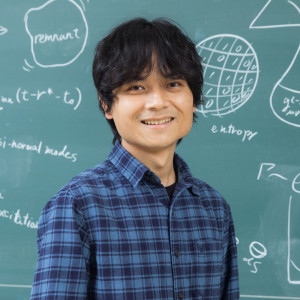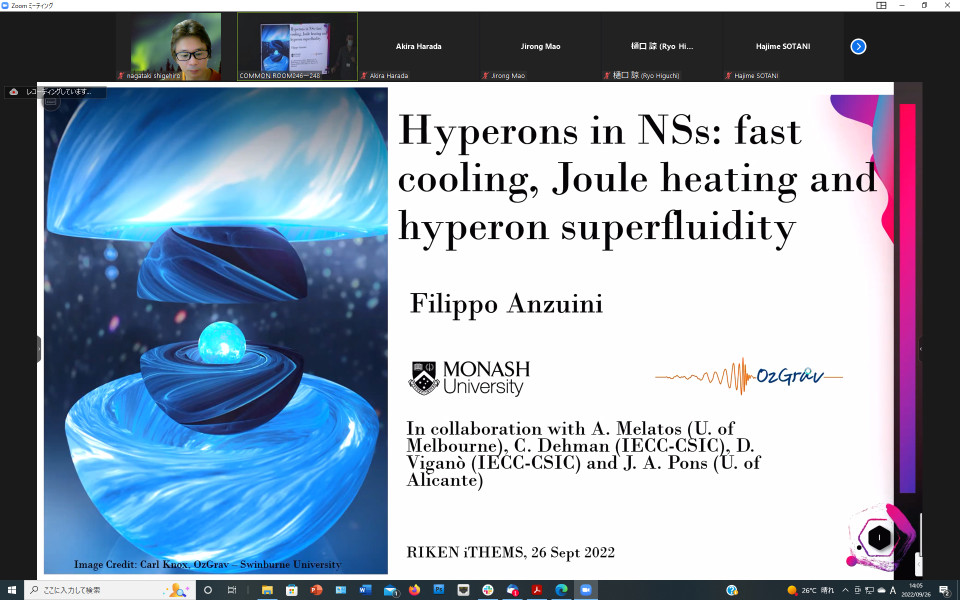Volume 218
Back to Newsletter List
Hot Topic
Farewell message from Dr. Michiya Mori
2022-09-27
Our colleague Michiya Mori moves on to a new carrier at Graduate School of Mathematical Sciences, The University of Tokyo as of October 1st. We all will miss him and wish him the best of luck in his latest endeavor. Here is a message from Michiya Mori:
I spent 1.5 years at iTHEMS as a special postdoctoral researcher. It was a very great experience for me (as a mathematician) to have an opportunity to communicate with scientistists from various backgrounds (not only mathematics). I am grateful to everyone. I can fortunately continue to be a member of iTHEMS as a visiting scientist. I hope to get closer to more iTHEMS members in the future.
From October, I become a project assistant professor of The University of Tokyo at Komaba Campus. Luckily iTHEMS has a satellite office in Komaba (SUURI-COOL Komaba). Probably I will sometimes be there, and I hope to see you again there soon!
Award
Dr. Naritaka Oshita received the "17th Seitaro Nakamura Prize"
2022-09-27
Our colleague Dr. Naritaka Oshita (Special Postdoctoral Researcher, iTHEMS) has received the "17th Seitaro Nakamura Prize." This prize recognizes the achievements of young researchers in the field of particle physics in a broad sense. The winning paper is entitled "Ease of excitation of black hole ringing: Quantifying the importance of overtones by the excitation factors." The award ceremony will be held in March 2023 at the Spring Meeting of the Japanese Physical Society.
Congratulations, Naritaka!
Reference
- Naritaka Oshita, Ease of excitation of black hole ringing: Quantifying the importance of overtones by the excitation factors, Phys. Rev. D 104, 124032 (2021), doi: 10.1103/PhysRevD.104.124032
Seminar Report
ABBL-iTHEMS Joint Astro Seminar by Dr. Filippo Anzuini on September 26, 2022
2022-09-26
Neutron stars challenge current models of highly dense matter. Despite being the targets of numerous observational campaigns (e.g. gravitational-wave searches and X-ray observations), their equation of state is still unknown. One of the most exciting possibilities is that “unconventional” particles such as hyperons may appear in neutron star cores. Hyperons have a major impact on the observed thermal luminosity, because they accelerate the cooling rate via direct Urca processes, which copiously increase the neutrino emission from the core. Such mechanism is often considered to be a key signature of hyperon concentrations at high densities. Hyperon superfluidity plays a major role as well, because it can suppress the neutrino emissivity exponentially. The hope is that a comparison of the theoretical cooling curves against the available data of thermally-emitting neutron star can hint towards the existence of hyperons and their superfluidity. There is one ingredient, however, that is often neglected in neutron star cooling models: internal heating. The magnetic field of neutron stars decays due to the dissipation of the electric currents circulating in the crust, generating substantial Joule heating in the shallower layers. The thermal power generated by this process can counterbalance hyperon fast cooling, making it difficult to infer the presence of hyperons from the available thermal luminosity data, and complicating the link between measured thermal emission and internal composition. The speaker showed that this is the case for magnetars, because their crustal temperature is almost independent of hyperon direct Urca cooling in the core, regardless of whether hyperons are superfluid or not. Likewise, thermal luminosity data of moderately magnetized neutron stars are not suitable to extract information about the internal composition, as long as hyperons are superfluid. During/after the talks, there were some interesting questions and discussions. The seminar was done in a hybrid style.
Reported by Shigehiro Nagataki
Hyperons in neutron stars: fast cooling, Joule heating and hyperon superfluidity
September 26 (Mon) 14:00 - 15:00, 2022
Upcoming Events
Seminar
ABBL-iTHEMS Joint Astro Seminar
Magnetic fields at extragalactic scales: origin from the early universe?
October 7 (Fri) 14:00 - 15:00, 2022
Ryo Namba (Senior Research Scientist, RIKEN Interdisciplinary Theoretical and Mathematical Sciences Program (iTHEMS))
Blazar observations have provided tantalizing evidence for the presence of magnetic fields in the extragalactic regions, where astrophysical processes may not be an efficient source for their generation. While a natural speculation is to associate the production of such large-scale magnetic fields to inflationary physics, it has been known that magnetogenesis solely from inflation is quite challenging. In this talk I will discuss some mechanisms, successful/unsuccessful, for production of magnetic fields in the primordial universe, as well as the constraints from theoretical consistencies and observational data.
Venue: via Zoom
Event Official Language: English
Seminar
DMWG Seminar
Gamma-ray emission from the Sagittarius Dwarf Spheroidal galaxy due to millisecond pulsars
October 28 (Fri) 17:00 - 18:00, 2022
Oscar Macias (Faculty of Science, University of Amsterdam, Netherlands)
The Fermi Bubbles are giant, gamma-ray emitting lobes emanating from the nucleus of the Milky Way discovered in ~1-100 GeV data collected by the Fermi Gamma-Ray Space Telescope. Previous work has revealed substructure within the Fermi Bubbles that has been interpreted as a signature of collimated outflows from the Galaxy's super-massive black hole. In this talk, I will show that much of the gamma-ray emission associated to the brightest region of substructure -- the so-called cocoon -- is likely due to the Sagittarius dwarf spheroidal (Sgr dSph) galaxy. This large Milky Way satellite is viewed through the Fermi Bubbles from the position of the Solar System. As a tidally and ram-pressure stripped remnant, the Sgr dSph has no on-going star formation, but I will demonstrate that the dwarf's millisecond pulsar (MSP) population can plausibly supply the observed gamma-ray signal. This finding plausibly suggests that MSPs produce significant gamma-ray emission amongst old stellar populations, potentially confounding indirect dark matter searches in regions such as the Galactic Centre, the Andromeda galaxy, and other massive Milky Way dwarf spheroidals.
Venue: via Zoom
Event Official Language: English
Paper of the Week
Week 5, September 2022
2022-09-29
Title: Dirac Fermion kinetics in three-dimensionally curved graphene
Author: Yoichi Tanabe, Yoshikazu Ito, Katsuaki Sugawara, Mikito Koshino, Shojiro Kimura, Tomoya Naito, Isaac Johnson, Takashi Takahashi, Mingwei Chen
doi: https://doi.org/10.1002/adma.202005838
arXiv: http://arxiv.org/abs/2010.03601v2
If you would like to cancel your subscription or change your email address,
please let us know via our contact form.
Copyright © iTHEMS, RIKEN. All rights reserved.





